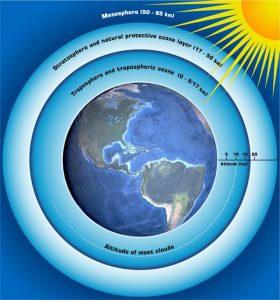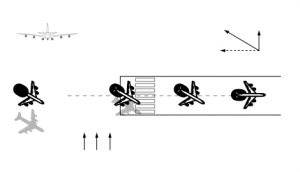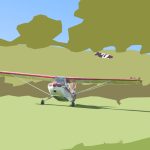
Weather will always get pilots talking. Although that’s admittedly not unusual among British folk, for pilots it can be a matter of life and death! Understanding how the weather works, and using the right resources to predict what is likely to happen at your airfield as you leave (and when you come back) are vital skills every pilot needs to practice.

What makes the weather?
Put simply, the Earth is round (for all that the flat theory still persists in certain loony corners of the internet) and can be thought of as the inner solid core of an onion. That onion then has several different layers around the core, forming the various layers of our atmosphere. Each of these layers has different characteristics and thicknesses as they lead progressively outwards to the black vacuum of space.
The solid Earth rotates around its own axis once every 24 hours, but the various onion layers – due to their lack of a physical anchor with Earth’s surface – spin at slightly different rates. Add to this difference the warming effects of the Sun, and the result is a swirling mixing bowl of heat, cold, moisture and dryness. All of the weather we experience on the surface (and up in the air) directly results from these differences in temperature and humidity.

As the air over warm surfaces rises, it begins to cool – causing the evaporated water within to condense and form clouds. The differences in temperatures also causes differences in the air pressure, forcing air to move from higher to lower pressures and resulting in the flow that we call wind. When opposing fronts of warm, wet air and cooler, dryer air meet, the result can be anything from a light shower to a violent storm.
Why does weather matter to pilots?
There are three pieces of weather-related information in which every pilot will be very interested – the speed of the wind, its direction, and visibilty.
The speed and direction of the wind is probably something you don’t often worry about, but for pilots these can make-or-break a flight. From tiny one-man microlights to gigantic passenger jets, all aircraft try to take off into wind. However, since this may not always be possible, it is important for a pilot to know the angle of the wind relative to the runway. Any wind blowing from a direction not aligned with the runway is called a crosswind. All aircraft have limits to their ability to cope with crosswind, and these are evaluated during the development and testing of each.

Visibility is important for much more obvious reasons – it’s always nice to see where one is going. Poor visibility can result from cloud and fog in cold, wet weather, but glaring sun and hot weather haze, less noticeable on the ground, can also be blinding for pilots – read about why some pilot’s prefer a crisp winter’s day here. That said, while good visibility is preferable, bad visibility need not be a complete showstopper given appropriate training and qualification as discussed here.
How is weather information presented to pilots?
As well as normal weather forecasts on television or radio, pilots have access to TAFs and METARs. The Terminal Aerodrome Forecast is a prediction of what weather will be like, whilst a Meteorological Aerodrome Report is the current reality based on measurements by weathermen or as automatically reported. The format for both reports was devised in 1968, and is based on a series of abbreviations designed to allow pilots to interpret them without needing to understand written English.
For example, the TAF for London Heathrow may be the following:
EGLL 041100Z 0412/0512 17010KTS 8000 +SHRA BKN010
This forecast for London Heathrow was released at 1100 UTC on the 4th day of the month and is valid from 1200 on the 4th to 1200 on the 5th. Wind is forecast to be from a direction of 170 degrees at a speed of 10 knots with 8000m visibility in heavy rain showers with ¾ of the sky covered by cloud which is at 1000 feet above the runway. There can be FEW, SCT and BKN cloud cover in the forecast roughly translating to ¼, ½ and ¾ whereas OVC means totally overcast.
…but forecasting weather is not an exact science and the METAR, the actual description of the weather, says something a bit different:
EGLL 041516Z 19020G26KTS 6000 –SHRA
The above describes the weather at London Heathrow (EGLL) at 1516 UTC on the 4th day of the month as the wind coming from 190 degrees gusting between 20 and 26 knots, with 6000m visibility in light rain showers.
There are abbreviations for all types of weather and, to begin with at least, decoding the forecasts and reports is like learning a new language. Both are freely available and regularly updated online though – so there’s no time like the present to get practising.

The wise pilot checks both of these before flying to make an informed decision. Weather can be fascinating, beautiful and rewarding to understand – but the Earth’s atmosphere can also throw some scary stuff your way!
Safe Flying!







